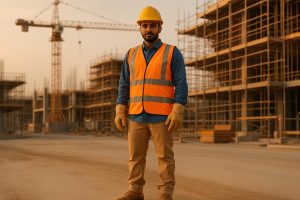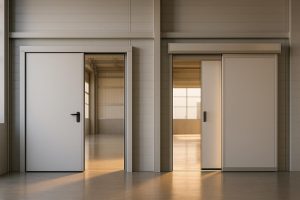
Here’s what you need to know:
Want fewer accidents on your site? Provide the right gear, train workers, and maintain equipment regularly.
Each type of safety equipment addresses specific risks workers face on construction sites.
Hard hats are a must for shielding against head injuries caused by falling objects, impacts, or electrical hazards, especially in Qatar’s construction sector. Today’s helmets often combine a tough outer shell with an internal suspension system to absorb shocks effectively. Given Qatar’s intense heat, ventilated designs that improve airflow are particularly helpful in reducing heat stress during the scorching summer months.
Working at heights comes with serious risks, and safety harnesses are critical for preventing injuries from falls. In Qatar, construction regulations mandate that workers operating at heights of 1.5 metres or more must wear a body harness and lanyard. When properly adjusted, these harnesses distribute the impact forces of a fall, offering vital protection for workers.
Gloves safeguard hands from hazards like cuts, abrasions, chemical exposure, and extreme temperatures. The material of the gloves should match the specific risk – whether it’s cut-resistant gloves for sharp tools or chemical-resistant ones for handling hazardous substances. Protective eyewear, on the other hand, keeps eyes safe from debris, dust, chemical splashes, and even radiation. Options like safety glasses with side shields or wraparound designs provide varying levels of coverage depending on the task.
High-visibility clothing plays a key role in ensuring workers are easily seen by machinery operators or vehicle drivers. Bright fluorescent colours combined with reflective strips enhance visibility under different lighting conditions. Respiratory protection is equally important, especially when dealing with construction dust, sand particles, or chemical fumes. N95 respirators are commonly used for filtering airborne particles, while half-face respirators or powered air-purifying respirators (PAPRs) provide added protection in high-risk environments.
These protective measures are essential for reducing risks related to falls, impacts, and hazardous exposures on construction sites.
Up next, we’ll explore how to select equipment that complies with Qatar’s standards and suits specific job requirements.
When selecting safety equipment in Qatar, it’s essential to prioritise compliance with local regulations, durability under extreme heat, and worker comfort. Striking the right balance between these factors ensures workers are well-protected while supporting the overall safety framework discussed earlier.
Qatar’s construction industry is governed by strict regulatory frameworks, including the Qatar Labour Law (No. 14) 2004 and the Qatar Construction Specification 2007. These regulations require contractors to adhere to specific safety standards. To ensure compliance, always verify that equipment meets CE, EN, or ISO certifications. Request supplier documentation to confirm that the safety gear is properly certified and capable of handling on-site hazards. This step not only reduces risks but also helps avoid potential legal issues. Once compliance is confirmed, focus on matching the equipment’s features to the tasks and conditions workers will face.
In Qatar’s challenging environment, safety gear must withstand extreme heat, dust, and intense sunlight. Start by identifying the specific hazards of each task. For example, workers handling chemicals need chemical-resistant gloves, while those working with sharp tools require cut-resistant materials. Beyond functionality, comfort plays a crucial role. Poorly fitting or uncomfortable gear is less likely to be worn consistently, putting workers at risk. Look for safety equipment with adjustable features and ergonomic designs to encourage regular use. Partnering with the right suppliers can make this process smoother and more effective.
Choosing experienced and trustworthy suppliers is key to securing high-quality safety equipment. Companies like Integrated Trading L.L.C, with nearly two decades of experience in Qatar’s industrial sector, provide valuable expertise in selecting gear suited to local conditions and regulations. Reliable suppliers not only offer certified equipment but also provide additional services such as training on proper usage and maintenance, which helps extend the lifespan of the gear. While budget constraints are understandable, never compromise on quality. Suppliers with local knowledge can suggest cost-effective options that meet safety standards, ensuring continuous protection and compliance as regulations evolve.
Ensuring safety on the job hinges on using equipment correctly, keeping it well-maintained, and storing it properly. In Qatar’s challenging environment, these practices, combined with proper training, are essential to extending the life of personal protective equipment (PPE).
With Qatar’s construction sites hosting a workforce from various cultural and linguistic backgrounds, effective safety training can be a complex task. Yet, it’s absolutely essential to prevent accidents and fatalities in the workplace.
To address this diversity, training programmes should include multilingual explanations and visual demonstrations. These sessions should cover everything from using PPE correctly to following safety protocols and work procedures. Tailoring the training to specific job roles ensures that operators, labourers, and other workers receive the guidance they need to perform their tasks safely.
Regular follow-ups are equally important. These can range from monthly toolbox talks to annual refresher courses. Additional sessions should be conducted after incidents, when new equipment is introduced, or when safety standards are updated. Topics might include emergency drills, hazard awareness, PPE usage, safety signage, and work procedures.
Toolbox talks and pre-shift briefings are also effective for reinforcing safety practices. They serve as quick reminders of proper equipment usage and help workers stay focused on safety. Once training is complete, routine inspections ensure that PPE remains in good working condition.
Daily inspections of PPE are an absolute must. Checking equipment before each use allows teams to spot wear and tear early, preventing minor issues from becoming major safety hazards.
In addition to daily checks, a more thorough inspection should be carried out every six months – or more frequently for heavily used equipment. Inspections should look for common issues like cracks, frayed straps, corrosion, contamination, lens fogging, worn soles, or expired equipment. Every inspection should be logged, noting the date, findings, corrective actions, and inspector’s details.
A documented care protocol not only reduces the risk of sudden equipment failure but also helps teams plan timely replacements. Following manufacturer guidelines and industry recommendations ensures that PPE is replaced before it becomes unsafe. These inspections also help determine whether equipment should be repaired, stored, or retired.
Qatar’s extreme climate can quickly degrade PPE. Heat, chemicals, and UV exposure are particularly harsh on materials, making proper storage critical to maintaining equipment performance. Ideally, PPE should be stored in cool, dry, and dust-free areas. Climate-controlled storage is especially important for sensitive equipment like electronics or hydraulic tools.
When indoor storage isn’t an option, high-quality tarps can shield equipment from moisture and dust, even in covered spaces. For electronic tools, batteries should be disconnected and stored separately in a cool, dry place. Training staff on proper storage techniques is essential to avoid damage caused by careless handling, like tossing equipment into containers.
Replacement should never be delayed when equipment shows visible damage or compromised protective features. Following manufacturer recommendations and adhering to industry standards can help set clear replacement criteria. In Qatar, where all workplace incidents must be reported within 24 hours and reviewed within three days, keeping equipment in top condition is vital to avoid injuries and regulatory issues.
Companies like Integrated Trading L.L.C., with years of expertise in Qatar’s industrial sector, can offer tailored advice on storage and maintenance solutions that account for the country’s harsh conditions. They can also assist in creating maintenance plans that address the accelerated wear caused by Qatar’s environment.
Beyond choosing the right equipment and keeping it in good condition, construction companies in Qatar face a range of challenges when it comes to putting safety practices into action. These obstacles are particularly tough in Qatar’s construction sector, which operates in one of the most demanding environments in the world. Addressing these challenges is essential to safeguarding workers.
Getting workers to consistently follow safety rules is a major hurdle in Qatar’s construction industry. Data on workplace fatalities reveals the serious risks associated with non-compliance. Several factors contribute to this issue, such as limited safety training, improper use of protective gear, and production deadlines that prioritise speed over safety. Adding to this, Qatar’s scorching summer temperatures, often exceeding 45°C, make wearing full protective equipment uncomfortable, leading some workers to skip it altogether.
To tackle these problems, management needs to take a proactive approach. Clear communication, frequent feedback, and ongoing training are key. When leaders actively enforce safety measures and show genuine concern for their teams, compliance rates tend to rise. Practical steps include conducting regular safety audits to check the condition of personal protective equipment (PPE) and introducing reward programs that recognise and encourage safe behaviour.
Communication is another significant challenge on Qatari construction sites. With nearly 85% of the population made up of foreign workers speaking over 100 different languages, language barriers are a daily reality. Many workers lack proficiency in Arabic or English, the primary languages used on-site, which can lead to misunderstandings of safety instructions and signage.
“Everyone is talking about the effect of Qatar’s extreme heat on a few hundred footballers, but they are ignoring the hardships, blood and sweat of thousands of migrant workers, who will be building the World Cup stadiums in shifts that can last eight times the length of a football match.”
- Umesh Upadhyaya, General Federation of Nepalese Trade Unions
To address this issue, companies should create multilingual safety materials and training programs that reflect the most common languages spoken on-site. Hiring bilingual supervisors has also proven effective in bridging communication gaps. These supervisors ensure that critical safety commands and emergency instructions are clearly understood. By improving communication, companies can also reduce issues related to equipment reliability and availability.
Ensuring a steady supply of reliable safety equipment is another challenge, particularly in Qatar’s harsh climate. The extreme heat and conditions can accelerate wear and tear on safety gear, making it essential to work with suppliers who understand these unique demands. High-quality, certified equipment that has been locally tested is crucial for maintaining safety standards.
Contractor pre-qualification programs are one way to ensure that only top-tier equipment is used. Additionally, technology can help by monitoring the condition of equipment, scheduling maintenance, and predicting when replacements will be needed. Regular on-site inspections can also catch supply issues before they become critical. Setting measurable goals, like key performance indicators (KPIs) for equipment reliability, can help companies track and improve their processes over time.
Companies such as Integrated Trading L.L.C., with a strong presence in Qatar’s industrial sector, offer valuable expertise in selecting and managing safety equipment. Their experience ensures that the gear not only meets international standards but is also suited to Qatar’s challenging environmental conditions.
In Qatar’s challenging industrial environment, construction safety equipment plays a vital role in preventing workplace injuries. A study by UAE University revealed that nearly two-thirds of hospital visits were linked to injuries sustained on construction sites, often due to insufficient or improper personal protective equipment (PPE). Qatar’s extreme conditions further highlight the need for well-suited safety solutions, as workers face risks that demand specialised equipment.
Given these risks, choosing the right safety equipment is crucial. It’s important that all equipment meets international standards such as CE, EN, or ISO certifications.
In Qatar’s harsh climate, safety gear must withstand extreme heat and UV exposure. Materials should resist degradation caused by intense sunlight and high temperatures, while also being comfortable enough to encourage workers to wear them consistently.
Proper training and regular maintenance are key to keeping safety equipment effective. Workers need detailed guidance on how to use, inspect, and recognise damaged equipment. Establishing clear care protocols helps prevent sudden failures and ensures that the gear continues to provide adequate protection.
Daily inspections are non-negotiable. Workers should check for issues like cracks, fraying, corrosion, or contamination before every shift. Additionally, PPE should be stored in cool, dry, and dust-free environments to extend its lifespan. These practices align with earlier recommendations focused on certifications, climate adaptability, and routine checks.
Improving workplace safety starts with conducting hazard assessments to determine the specific PPE needs of each role. This involves examining both immediate risks and long-term exposure challenges unique to Qatar’s industrial settings.
Collaborating with experienced suppliers is another crucial step. Seasoned providers, such as Integrated Trading L.L.C., which has 18 years of experience in Qatar’s industrial sector, can help businesses navigate local requirements while ensuring compliance with international safety standards.
Regular audits, updated training programs, and expert consultations are essential for maintaining effective safety practices. This proactive approach ensures that safety measures evolve alongside the demands of Qatar’s construction industry, creating a safer work environment for everyone involved.
In Qatar, construction companies must adhere to the Qatar Foundation Construction Safety Standards, which set out clear requirements for health, safety, security, and environmental practices. A key focus of these standards is the mandatory use of certified personal protective equipment (PPE), such as hard hats, safety harnesses, gloves, and protective eyewear, all designed to meet local safety regulations.
Moreover, companies are responsible for ensuring that safety equipment, like fall protection systems – including body harnesses and lanyards – complies with both local and internationally recognised safety certifications. These measures aim to reflect global best practices while addressing Qatar’s unique workplace safety needs, ensuring construction sites remain secure and compliant.
Training a multilingual workforce in Qatar means developing clear communication strategies and using practical methods to ensure everyone knows how to use safety equipment correctly. Incorporating multilingual instructors, providing translated materials, and using visual aids like diagrams or videos can help overcome language barriers effectively. Hands-on sessions and practical demonstrations are equally important to reinforce proper techniques.
Interactive tools, such as simulations or role-playing exercises, can make training sessions more engaging and memorable. Encouraging workers to ask questions and give feedback also plays a key role in creating a strong safety culture, helping them feel supported while improving adherence to safety protocols.
To keep construction safety equipment in top condition under Qatar’s harsh climate, regular upkeep and inspections are a must. Pay attention to cleaning, inspecting for any damage, and replacing worn-out components without delay – especially for essentials like hard hats, safety harnesses, and gloves. Using protective coatings and waterproof treatments can offer extra defense against the region’s intense heat, high humidity, and sand.
Proper storage is equally important. Keep equipment in cool, dry spaces to avoid damage from constant exposure to heat and sunlight. On top of that, ensure workers are monitored for heat stress and have access to plenty of water and cooling options. This approach not only preserves the safety gear but also supports worker health in Qatar’s demanding weather conditions.

He Established Integrated Trading Company L.L.C in 2006 at qatar , and has partnered with high quality international manufacturers that represent the best in each of our product categories.
With over 2 decades of experience running the company , he shares his valuable insights that he learned from being in the market through this blog


